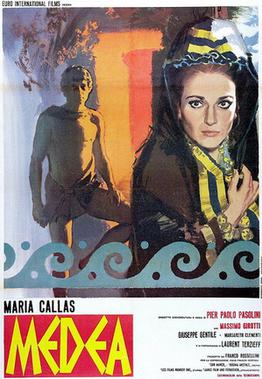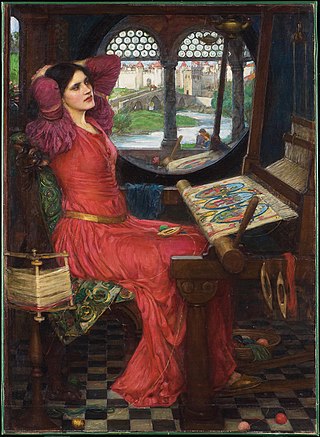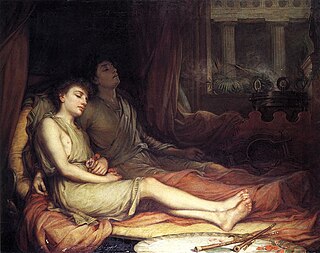
Jason was an ancient Greek mythological hero and leader of the Argonauts, whose quest for the Golden Fleece is featured in Greek literature. He was the son of Aeson, the rightful king of Iolcos. He was married to the sorceress Medea, the granddaughter of the sungod Helios. He was also the great-grandson of the messenger god Hermes, through his mother's side.

In Greek mythology, Medea is the daughter of King Aeëtes of Colchis. In the myth of Jason and the Argonauts, she aids Jason in his search for the Golden Fleece. She later marries him, but eventually kills their children and his other bride according to some versions of her story. Medea is known in most stories as a sorceress and is often depicted as a priestess of the goddess Hecate. She first appears in Hesiod's Theogony around 700 BCE, but is best known from Euripides's tragedy Medea and Apollonius of Rhodes's epic Argonautica.

Pelias was king of Iolcus in Greek mythology. He was the one who sent Jason on the quest for the Golden Fleece.

The Argonauts were a band of heroes in Greek mythology, who in the years before the Trojan War accompanied Jason to Colchis in his quest to find the Golden Fleece. Their name comes from their ship, Argo, named after its builder, Argus. They were sometimes called Minyans, after a prehistoric tribe in the area.

In Greek mythology, Talos, also spelled Talus or Talon, was a giant automaton made of bronze to protect Europa in Crete from pirates and invaders. He circled the island's shores three times daily.

Jason and the Argonauts is a 1963 independent fantasy adventure film distributed by Columbia Pictures. It was produced by Charles H. Schneer, directed by Don Chaffey, and stars Todd Armstrong, while co-starring Nancy Kovack, Honor Blackman, and Gary Raymond.

John William Waterhouse was an English painter known for working first in the Academic style and for then embracing the Pre-Raphaelite Brotherhood's style and subject matter. His paintings are known for their depictions of women from both ancient Greek mythology and Arthurian legend. A high proportion depict a single young and beautiful woman in a historical costume and setting, though there are some ventures into Orientalist painting and genre painting, still mostly featuring women.
Medea is a tragedy by the ancient Greek playwright Euripides based on a myth. It was first performed in 431 BC as part of a trilogy, the other plays of which have not survived. Its plot centers on the actions of Medea, a former princess of the kingdom of Colchis and the wife of Jason; she finds her position in the world threatened as Jason leaves her for a princess of Corinth and takes vengeance on him by murdering his new wife and her own two sons, before escaping to Athens to start a new life.

In Greek mythology, Iynx was an Arcadian Oread nymph; a daughter of the god Pan and the nymph Echo. In popular myth, she used an enchantment to cast a spell on Zeus, which caused him to fall in love with Io. In consequence of this, Hera metamorphosed her into the bird called Lynx.

Jason and the Argonauts, is a 2000 American two-part television miniseries directed by Nick Willing and produced by Hallmark Entertainment. It is based on the Greek myth of Jason and the Argonauts.

Medea is a 1969 Italian film directed by Pier Paolo Pasolini, based on the ancient myth of Medea. The film stars opera singer Maria Callas in her only film role and is largely a faithful portrayal of the myth of Jason and the Argonauts and the events of Euripides' play The Medea.

The Magic Circle is an 1886 oil painting in the Pre-Raphaelite style by John William Waterhouse. Two copies of the painting were produced. The two paintings and a study depict a witch or sorceress using a wand to draw a fiery magic circle on the Earth to create a ritual space for her ceremonial magic. As was common in the period, Waterhouse repeated his subject on a smaller scale, probably at the request of a collector.

The Lady of Shalott is a painting of 1888 by the English painter John William Waterhouse. It is a representation of the ending of Alfred, Lord Tennyson's 1832 poem of the same name. Waterhouse painted three versions of this character, in 1888, 1894 and 1915. It is one of his most famous works, which adopted much of the style of the Pre-Raphaelite Brotherhood, though Waterhouse was painting several decades after the Brotherhood split up during his early childhood.

The Unwelcome Companion: A Street Scene in Cairo is an early painting by John William Waterhouse. Completed in 1873, it was exhibited at the gallery of the Society of British Artists.

I Am Half-Sick of Shadows, Said the Lady of Shalott is a painting by John William Waterhouse completed in 1915. It is the third painting by Waterhouse that depicts a scene from the Tennyson poem, "The Lady of Shalott". The title of the painting is a quotation from the last two lines in the fourth and final verse of the second part of Tennyson's poem:

Sleep and His Half-Brother Death is a painting by John William Waterhouse completed in 1874.

Hylas and the Nymphs is an 1896 oil painting by John William Waterhouse. The painting depicts a moment from the Greek and Roman legend of the tragic youth Hylas, based on accounts by Ovid and other ancient writers, in which the enraptured Hylas is abducted by Naiads while seeking drinking water.

The dramatic episodes in which Greek mythology character Medea plays a role have ensured that she remains vividly represented in popular culture. Titles are ordered chronologically.
Medea is a 1730 play by the British writer Charles Johnson. It is about Medea from Greek mythology and based on the play Medea by Euripides.


















